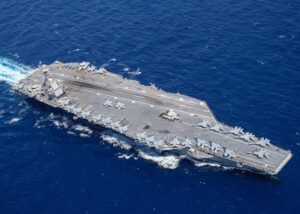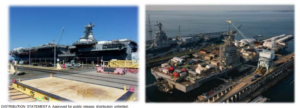The Navy’s newest aircraft carrier, the USS Gerald R. Ford (CVN-78), is set to deploy next month while the second new carrier will still deploy on time despite changes to its delivery schedule, a program official said last week.
At the beginning of the month, CVN-78 returned from its composite training unit exercise (COMPTUEX), which served as its “final graduation exercise” consisting of weeks of working on certifications and requirements to deploy with its air wing and battle group ships, Capt. Brian Metcalf, manager of the Ford-class aircraft carrier program, said April 4 during the Navy League’s annual Sea Air Space symposium.

Metcalf noted the Ford is now expected to deploy in the first week of May for at least six months.
When asked about the ship’s sortie generation rate, he noted it takes several days to measure that and the Navy will conduct an official measurement after the upcoming deployment because all the crew and systems must first be fully proficient and ready.
“It requires a trained crew, reliable systems and a very knowledgeable air wing. That test is going to happen after this operational deployment when we go do the full on multi-day event,” Metcalf said.
The Ford-class was meant to have a higher sortie generation rate than the previous Nimitz-class rate of 120 sorties in a 12-hour period or 240 in 24 hours. CVN-78 was supposed to be capable of up to 160 sorties over a 12-hour period and surge to 270 sorties in a 24-hour period.
“We have collected data on the aircraft’s ability to land, turn around, rearm and get launched again. And we have set records that are above Nimitz flight levels on individual days. The long-term graduation exercise that’s going to cover approximately a week is something that the crew has to be ready for, the ship has to be ready for. And frankly, the systems have to be ready for that. That week-long final measurement of sortie generation rate will happen after this deployment,” Metcalf said.
He added that the Ford’s new Electromagnetic Aircraft Launch System (EMALS) and Advanced Arresting Gear (AAG) used to launch and recover jet aircraft are “operating fine,” having measured over 14,000 catapult launches and recoveries.
“We’ve got lots of supportability improvements, they’re actually leveling out to be dependable systems that we can rely on,” Metcalf continued.
He also provided updates on the next three aircraft carriers in production, the future John F. Kennedy (CVN-79), Enterprise (CVN-80) and Doris Miller (CVN-81). All Navy aircraft carriers are built by HII Newport News Shipbuilding [HII].
The future John F. Kennedy (CVN-79) is “nearly 90 percent complete” with about 60% of compartments turned over to the crew. The shipbuilder and Navy are in the middle of testing the ship, having started with the power plant and electrical systems, but now moving on to EMALS.
Metcalf said soon “we’ll be beginning the process of lighting off individual combat systems.”
He acknowledged the delivery timeline for CVN-79 changed from 2024 to 2025, a fact noted in the Navy’s fiscal year 2024 budget request documents (Defense Daily, March 24).
Metcalf confirmed the change is due largely to moving from a two phase to single phase delivery schedule.
“The original plan was to deliver 79 like 78…To do that we would have planned a long post-delivery timeline, we have lots of lessons learned from 78, with 5,000 sailors on board and the air wing. They provided all the operational experience and lessons learned and we had a long list of post-construction post-delivery modifications to improve capability,” he said.
‘Instead of delivering the ship, and working through a very long post-shakedown availability time period – Since we had done almost all of that work on 78 already, we understood it and we had the technical requirements laying flat to get it done – We picked that work up and are we’re going to insert it into the timeline before delivery,” Metcalf continued.

In 2020 the Navy switched from the dual-phase to single phase delivery schedule to mitigate schedule risks and lower post-delivery costs (Defense Daily, March 27).
The original plan would have had CVN-79’s mechanical and electrical construction be delivered by the middle of FY ‘22, then undergo a nine-month post-delivery shakedown, then an 18-month post-shakedown availability/selective restricted availability for Phase II work to incorporate items like the Enterprise Air Surveillance Radar (EASR) and procure and install electronics as late as possible.
Metcalf says now CVN-79 will deliver more like CVN-80 and 81 and less like 78 without changing the deployment schedule.
‘We’re able to maintain the deployment timeline for the ship. She will still deploy on time because we won’t have the long planned post-delivery timeline that we originally planned for by inserting that work before delivery. So we’re basically just rearranging some of the dates between now and the operational deployment and resequencing the delivery of work that was planned two years out, we’re able to pull in now.”
Metcalf also said construction of the future USS Enterprise (CVN-80) is over 25 percent complete, with the hull currently sitting at 550 feet long at HII’s shipyard. The future USS Doris Miller (CVN-81) is currently in the material procurement stage and in its initial construction stage with some reactor plant bulkheads and some inner bottoms underneath the ship under construction. CVN-81 is planned to be delivered in 2032.
He argued the important point about CVN-81 production is how the Navy is seeing the advantages of buying CVN-80 and 81 at the same time. The plan was expected to save upward of $4 billion compared to buying the carriers one at a time (Defense Daily, Jan. 31, 2019).
“Most importantly, we are seeing in 81 the advantages of the two-ship buy, probably even more so than we expected…So for this ship that delivers in 2032, over 70 percent of the purchase orders from Newport News are in place already. That’s almost a 50 percent increase from where it will be if it was a single ship buy and over the course of the last three years, that stability and that cash flow and that dependability has probably saved us unestimatable millions of dollars with the inflation and labor shortages and supply chain problems that have affected the world, frankly, since then. So we are seeing those improvements,” Metcalf said.
When asked how the savings are stacking up compared to that initial $4 billion figure, he said that amount was already saved in the initial order.
“When we put the ships under contract $4 billion was taken off of the single ship estimated values of what those contracts would be. So we have already saved that $4 billion, in a full budgetary perspective.”
However, Metcalf admitted a few unspecified things “that detract from that” like certain parts where his office cannot take advantage of a two-ship part of the deal and “there are a handful of reasons why some of that has happened.”
He said his office is also working on giving an update given changes in prices and inflation since the contract award.
“If I would have bought 81 in FY 23 instead of FY 19 how much would it have cost me and we’re working on an estimate to provide that. But I can stand here today and tell you I am certain it would be way more given what happened between 2020 and 2023 – that we would have paid a lot more for that ship than what we have on contract today.”
Metcalf said after this experience NAVSEA is “on track to recommend another two-ship buy” for the next set of carriers.